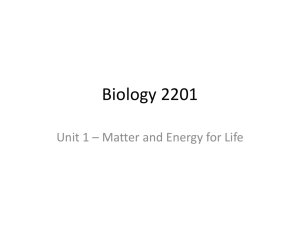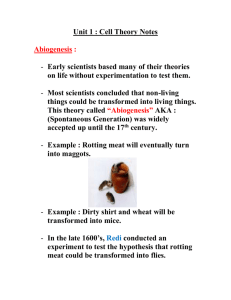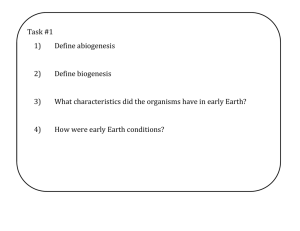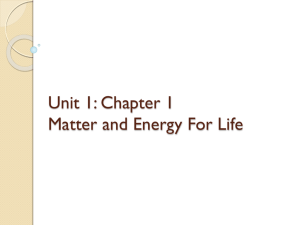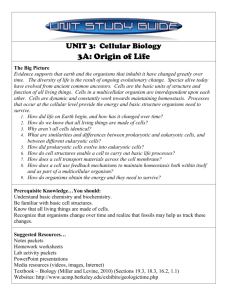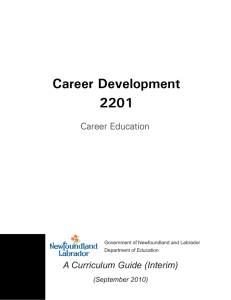biology 2201 ch 1.1 notes.notebook
advertisement
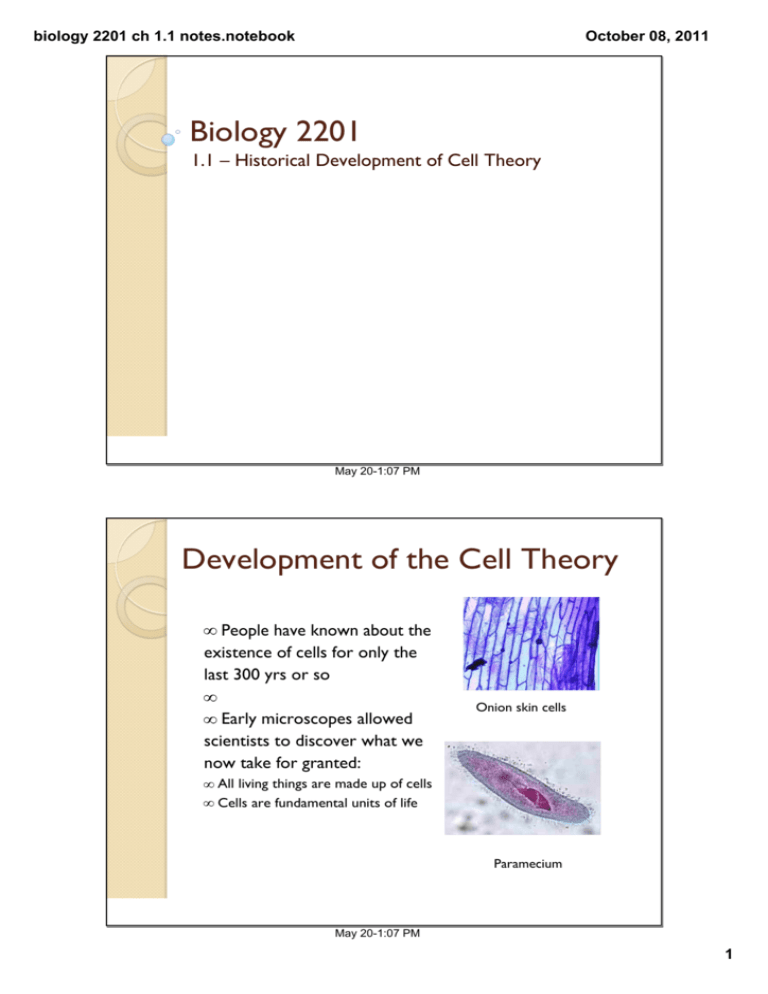
biology 2201 ch 1.1 notes.notebook October 08, 2011 Biology 2201 1.1 – Historical Development of Cell Theory May 20­1:07 PM Development of the Cell Theory • People have known about the existence of cells for only the last 300 yrs or so • • Early microscopes allowed scientists to discover what we now take for granted: Onion skin cells • All living things are made up of cells • Cells are fundamental units of life Paramecium May 20­1:07 PM 1 biology 2201 ch 1.1 notes.notebook October 08, 2011 Cell Theory • In a sense, all biology is based on the fact that all living things are made up of units called cells. As well, these cells are the functional units of an organism. • Cell Theory • 1. all living things are made up of one or more cells • 2. cells are the basic units of structure and function in all organisms • 3. all cells come from pre-existing cells • 4. in a multicellular organism, the activity of the organism depends on the total activity of its independent cells May 20­1:07 PM Going Back A Few Years • Cell theory was stated first in 1858, challenging the believe system at the time • People believed small animals could arise spontaneously from non-living or dead things • “Spontaneous Generation” • Thomas Huxley renamed it to “abiogenesis” • Live coming from life came to be called “biogenesis” Thomas Huxley May 20­1:07 PM 2 biology 2201 ch 1.1 notes.notebook October 08, 2011 Abiogenesis vs. Biogenesis • Before the development of cell theory in 1858, the idea that living things could only come from other living things was not believed. Many people felt that some living things could come from non-living things. • Abiogenesis (spontaneous generation): the idea that living things can come from nonliving things • Biogenesis: the idea that living things can only come from other living things May 20­1:07 PM Evidence for Abiogenesis Evidence that supported abiogenesis Fact or Fiction Fiction – Maggots were present, but only after the Maggots suddenly appeared on uncovered meat after several days flies laid their eggs on the meat Frogs and salamanders suddenly appearing on or in mud Fiction – These amphibians hibernate and burrow into the mud and come to the surface to eat Jan Baptista van Helmont said that Fiction – The mice that were attracted to the food source ﴾wheat﴿ arrived, and then mated. They mixing a dirty shirt with wheat possibly hid in the mixture grains would produce adult mice that would then mate. John Needham’s experiment with meat broth teeming with microbes after being boiled. Fiction – He did not boil the broth long enough to kill all the bacteria in the broth, and so they divided, making the broth cloudy. May 20­1:07 PM 3 biology 2201 ch 1.1 notes.notebook October 08, 2011 Key Events in Biological History • Aristotle observes and formulates ideas about nature. • He was the first to divide organisms into two groups (kingdoms) • Plants – those that don’t move • Animals – those that move • Aristotle supported spontaneous generation. May 20­1:07 PM More History • After studying the nature of reproduction, William Harvey begins to question the idea of abiogenesis, suggesting that maggots on meat come from eggs that are too small to see. This was during the 1600’s, and we now know this to be true • • Robert Hooke writes a book, in which it shows illustrations of tree bark as seen under the microscope. The drawing showed compartments he called “cells” • • Antony van Leeuwenhoek designed his own microscope with a tiny simple lens. He reported that he seen tiny “animalcules” or tiny organisms that moved. This marked the discovery of bacteria, the simplest of all living organisms. Leeuwenhoek developed microscopes that had the clearest quality image at the time. Bark cells May 20­1:07 PM 4 biology 2201 ch 1.1 notes.notebook October 08, 2011 Francesco Redi • Conducted one of the first controlled experiments that supported biogenesis. He used meat in jars, half covered with mesh and half open. After several days he found that the mesh-covered meat had no maggots, while the open jar had maggots. • See page 8 in textbook May 20­1:07 PM Needham & Spallanzani • John Needham designed and experiment that incorrectly supported abiogenesis. He boiled a meat broth for a short period of time, and poured it into two flasks, covered and uncovered. Both became cloudy because of bacterial growth after several days. He believed that the organisms came from the water itself. He did not boil the water long enough to kill all the bacteria. • • Lazzaro Spallanzani didn’t agree with Needham, and so repeated Needham’s experiment. This time the broth was boiled for a longer time. No life appeared in the sealed flask, while the open flask had bacterial growth. Boiling the broth “killed the vital principle” that made life arise from non-living matter like water. May 20­1:07 PM 5 biology 2201 ch 1.1 notes.notebook October 08, 2011 Other Scientists • Robert Brown observed cells from various organisms and noticed that they all had a dark region in them. This dark region has recently been called the nucleus. • • Matthias Jacob Schleiden, a botanist, said that “all plants are made up of cells” • • Theodor Schwann wrote that “all animals are made up of cells” and then added that “cells are organisms, and animals and plants are collectives of these organisms” • • Alexander Carl Henrich Braun said “cells are the basic unit of life” • Jugo von Mohl said that “protoplasm is the living substance of the cell” then added that “cells are made up of protoplasm enveloped by a flexible membrane” • Rudolph Virchow wrote that “cells are the last link in a great chain [that forms] tissues, organs, systems and individuals… where cells exist there must have been pre-existing cells…” May 20­1:07 PM Louis Pasteur • conducted experiments that disproved abiogenesis, concluding that organisms do NOT arise from non-living matter. • Goose-neck flask experiment is the guiding principle behind pasteurization Pasteur’s Experiments May 20­1:07 PM 6
